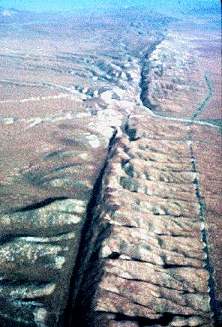Plate Boundaries and EarthquakesAn earthquake is the shaking of the Earth as a result of crustal movement. Earthquakes emanate from faults, or fractures in the Earth where movement occurs. Most earthquakes occur at the boundaries where plates meet. Submarine earthquakes create seismic ocean waves that travel long distances across the ocean. They often strike land with devastating consequences. [For an animation of how earthquakes are propagated see "The Savage Earth" - The Restless Planet: Earthquakes animation , NOVA, PBS].The location of earthquakes and the ruptures associated with them are what scientists use to define plate edges. The association between plate boundaries and earthquakes is shown in Figure 15.20.
Figure 15.20 Cumulative global earthquakes 1960
-1995
There are several different kinds of faults classified according to the type of movement that occurs. Where plates move horizontally past one another, transform faults occur. Such is the case of the San Andreas Fault in California. Where the crust is spreading apart, like the mid-ocean ridge, shallow earthquakes (within 30 kilometers of the surface) are common. Shallow to deep earthquakes occur along subduction zones where one plate overrides another, like that which occurs along the northwest coast of the United States, western Canada and southern Alaska. Figure 15.21 San Andreas Fault, California, is where numerous earthquakes occur due to slippage along two plate boundaries. (Source: USGS Used with permission)
|

